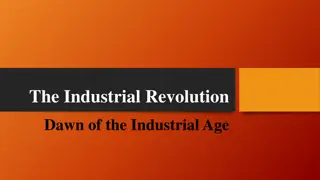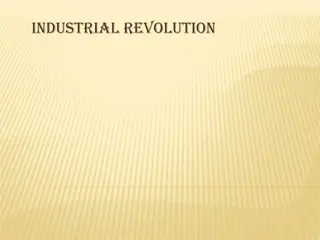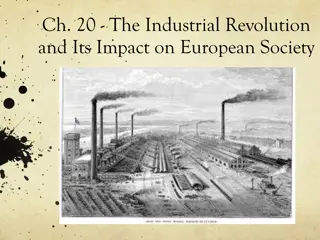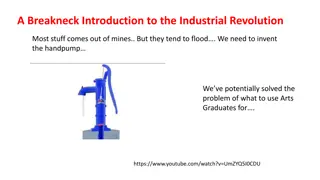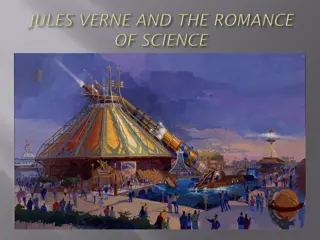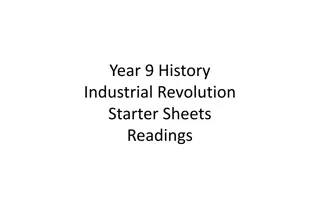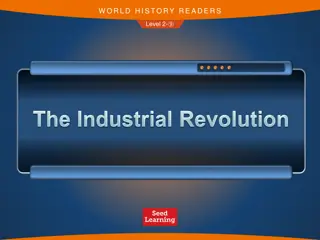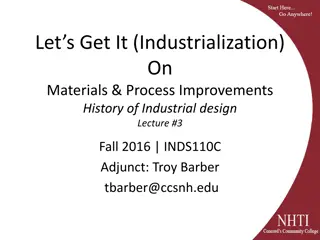American Industrial Revolution and Innovations
The American industrial revolution transformed the economy and society with advancements in transportation, manufacturing, and communication. Steamboats, railroads, and innovations like the cotton gin and steel plow revolutionized production, while the North led industrialization with factors like access to capital and cheap labor. Explore how inventions like the telegraph and interchangeable parts reshaped daily life and work during this period of growth and change.
Download Presentation

Please find below an Image/Link to download the presentation.
The content on the website is provided AS IS for your information and personal use only. It may not be sold, licensed, or shared on other websites without obtaining consent from the author.If you encounter any issues during the download, it is possible that the publisher has removed the file from their server.
You are allowed to download the files provided on this website for personal or commercial use, subject to the condition that they are used lawfully. All files are the property of their respective owners.
The content on the website is provided AS IS for your information and personal use only. It may not be sold, licensed, or shared on other websites without obtaining consent from the author.
E N D
Presentation Transcript
Roadways -Turnpikes- roads for which users pay a toll. -income used to improve roads and ease travel -National Road- a roadway that extended west from Maryland to the Ohio River. Image result for national road
Image result for steam boat Steamboat/Steam- Powered Ships -easier to travel upstream against the current. Erie Canal -1825, runs 363 miles across N.Y. from Lake Erie to the Hudson River -provided efficient water transportation that linked farms to cities Image result for erie canal map
Image result for transcontinental railroad Railroads -cost less to build and could easily scale hills -faster than ships -carried more weight Image result for transcontinental railroad
Industrial Revolution -Great Britain (1700s) -changed economy, culture, social life, politics Textile Mills/Factories -changed the speed and volume of production -increased pace of work -divided labor into small tasks -reduced amount of skill/training
Image result for eli whitney Image result for cotton gin Eli Whitney -interchangeable parts- identical components that could be used in place of the other -cotton gin Samuel Morse -electric telegraph- electrical pulses to travel long distances along metal wires as coded signals John Deere -steel plow Cyrus McCormick -mechanical reaper Image result for samuel morse Image result for john deere steel plow Image result for cyrus mccormick Image result for john deere steel plow
The North -Industrialization occurred mainly in the North -greater access to capital- money needed to build factories -cheap labor -Tariff of 1816 -designed to protect American industry -increase the price of imported manufactured goods.
Labor Unions -groups of workers who united to seek better pay and conditions Middle Class -middle class emerges
The South -boom in cotton production helped deepen the region s commitment to slavery -cotton gin- reduced amount of time and the cost separating the cotton seeds from the white fiber -demand for slaves increased as cotton became more profitable
Economic -cotton production limited regional development -plantations dispersed the population -South did not attract immigrants to region Cultural -illiteracy was high -racial division within society
Election of 1828 - Jacksonian Democracy emerges - Jackson supports refer to themselves as Democrats, not Democratic Republicans - victory symbolized the triumph of the democratic style over aristocracy - promise the return of Jeffersonian principles: strong states and a weak federal government
Native American Removal - Jackson s supporters were mainly from the South - Southerners expected Jackson to remove Native Americans living in the region - many denounced their civilizations and wanted their valuable lands - President Jackson ignored the Supreme Court s decision (land seizure was unconstitutional) and favored states rights in this case
- Indian Removal Act of 1830- negotiate the exchange of American Indian lands in the South for new lands in the Indian Territory (Oklahoma) Image result for trail of tears Trail of Tears- 1838, U.S. soldiers forced Cherokees to walk from their lands in the Southeast to Oklahoma.
Tariff of Abominations- high tariffs adopted by Congress designed to promote American industry. - the North favored these protective tariffs but the South disliked them Nullification- states could nullify, or void, any federal law deemed unconstitutional *many state legislatures passed resolutions rejecting nullification
Jackson Opposed the Bank - Money Power - Jacksonian Democrats disliked the second Bank of the United States- chartered by Congress in 1816 - they believed it favored rich investors, saw it as dangerous and corrupt - business leaders valued the Bank- believed it promoted economic growth, provided a stable currency (paper money), instilled confidence.
Whigs - political party - formed by Bank supporters after Jackson vetoed the charter renewal of the Bank - nationalists who wanted a strong federal government to manage the economy - broad interpretation of the Constitution - protective tariffs, national bank *emergence of the Whigs renewed the two-party politics in the United States.





